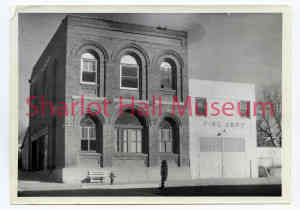By Parker Anderson
The Prescott city government has put the old city hall building at the corner of Goodwin and Cortez streets up for sale. This has brought about questions concerning the history of the building and of the property itself.
 In 1962 prominent Prescott historian Budge Ruffner was Chairman of the Prescott Centennial Commission, which was in charge of preparations for Prescott’s 100th anniversary two years later. With the city administration planning to build a new city hall on a then-vacant lot, Ruffner asked commission member Bert Fireman to document the history of the site.
In 1962 prominent Prescott historian Budge Ruffner was Chairman of the Prescott Centennial Commission, which was in charge of preparations for Prescott’s 100th anniversary two years later. With the city administration planning to build a new city hall on a then-vacant lot, Ruffner asked commission member Bert Fireman to document the history of the site.
Fireman’s findings, published in the Prescott Courier on August 28, 1962, revealed that the site was the first lot ever sold in Prescott. According to writings by both pioneer jurist Edmund Wells and territorial historian Thomas Farish, the lot was sold on June 6, 1864 to future postmaster Samuel Curtis Rogers for $175.00. Today, a small historic plaque on the city hall building behind the flagpole denotes the lot as the first one sold in Prescott.
Ten years later, Rogers sold the lot to a “Mr. Meacham” who sold the lot the following year to James Howey. Howey entered into a partnership with the Goldwater brothers to erect a large mercantile store on the site. Three years later, the Goldwaters constructed another building at the corner of Cortez and Union streets and moved their operations there.
 James Howey seemed unable to find permanent tenants. He ultimately rented his building (which had become known as Howey’s Hall) for many private events such as parties and political gatherings. However, increasing debt caused Howey to lose the property, and it was sold in a Sheriff’s sale to businessman Levi Bashford. After Bashford’s death, the City of Prescott acquired the property from Bashford’s estate in 1904.
James Howey seemed unable to find permanent tenants. He ultimately rented his building (which had become known as Howey’s Hall) for many private events such as parties and political gatherings. However, increasing debt caused Howey to lose the property, and it was sold in a Sheriff’s sale to businessman Levi Bashford. After Bashford’s death, the City of Prescott acquired the property from Bashford’s estate in 1904.
In 1959, with the thought of possibly constructing a new building for the city government, the city demolished Howey’s Hall, rendering the site a vacant lot once again. “Historic preservation” of old buildings was not an issue in those days. Howey’s Hall was viewed as just another derelict old building, and few mourned its passing.
In the early 1960s, Prescott moved ahead with plans to construct its first ever actual city hall building on the site. The architectural firm of Allan & Olsson was hired to design the facility, and they came up with a “building block” design. Today, the building is viewed as unattractive, but this type of “modern” design was popular in its day, and the building evokes its era very well.
After soliciting bids for construction, the city contracted with the Tucson-based firm of Mott & Lane Construction Co., Inc. Mickey Lane and Bill Mott submitted a bid of $255,363 for construction, with an additional $19,200 for designer “terrazzo” floors, halls and steps, also modern for the time.
Groundbreaking for construction occurred on September 6, 1962, in a small ceremony led by Mayor Frank Tutt and the Prescott City Council. On September 13, 1962, in another ceremony, Steven Ayvan, a collector of antique clocks, donated an 1893 French-made gold-inlaid table clock to the Prescott city government, to be displayed in the City Council chambers when the building was completed. The Courier ran a front-page photo of Ayvan and the clock posing with Mayor Tutt and City Manager Art Bunger. Today, the clock has not been seen in the city hall anytime in recent memory, and its whereabouts and fate are unknown.
Next week: The building is completed.
“Days Past” is a collaborative project of the Sharlot Hall Museum and the Prescott Corral of Westerners International (www.prescottcorral.org). This and other Days Past articles are also available at archives.sharlothallmuseum.org/articles/days-past-articles/1 The public is encouraged to submit proposed articles and inquiries to dayspast@sharlothallmuseum.org Please contact SHM Research Center reference desk at 928-277-2003, or via email at archivesrequest@sharlothallmuseum.org for information or assistance with photo requests.


